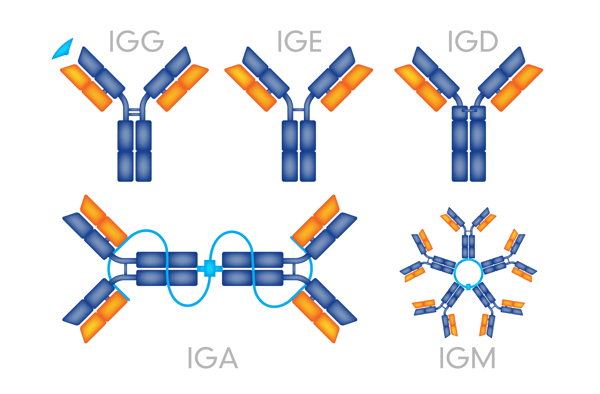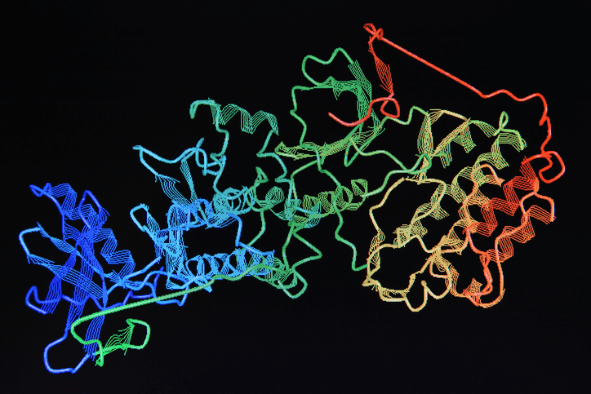Proteins are one of the four macromolecule building blocks of life. The other three are carbohydrates, lipids, and nucleic acids. Proteins are long strings of amino acids that fold together into what are called “hierarchical structures” in order to perform specialized functions within the cells and tissues of all living organisms.
Let’s describe what the hierarchical structures for proteins are. First is the chain of amino acids that make up a protein, called its primary structure. Each amino acid has a “side chain” composed of elements that make that amino acid unique. Side chains are grouped into hydrophobic, polar, and charged, which give rise to different interactions. The side chains interact with one another to create the next part of the hierarchical structure, the secondary structure. The secondary structure takes the form of an alpha helix or beta sheet. The next structure is known as tertiary structure, in which the sheets and helices interact in an physically and chemically favorable way to create a “folded” structure. When multiple tertiary structures come together to form a bigger structure, that is called the quaternary structure.
These higher structures are imperative to the proper function of the protein within it biochemical pathway. The tertiary structure creates the chemical and morphological landscape that imparts the biorecognition abilities to ligand, receptors, antibodies, and all of the other workhorse proteins in the organism. The hydrophobicity or electrostatic nature of the binding pockets are responsible for the specific affinities between proteins. It is no wonder that the ability to analyze proteins with a protein assay is fundamental to biological research and clinical diagnosis.
Purpose of Protein Assays
The purpose of the protein assay is to determine the amount or concentration of a specific protein or an array of different proteins in a sample. Isolating and detecting protein is used for many clinical and research processes. This can be a primary step before further manipulation in a research and development process, an initial capture of protein before structural analysis, or it can be a final detection step in a clinical laboratory as part of a disease diagnosis.
There are many different types of protein assay, and variations upon the major techniques. The topic is so dense that major biological supply companies typically create extensive handbooks, that explain the details of each protein assay. Here we provide a simple overview of the different protein assay types.
Protein assay types
1. UV absorbance and spectrophotometry :
The aromatic side chains of amino acids absorb light in the UV range. This means that UV absorption can serve as a readout of aromatic amino acid proportion and can help with protein identification and concentration. The concentration can be derived from knowing the number of aromatic side chains present in a protein or using the generally known proportion of aromatic side chains in proteins. This is a relatively nonspecific method of quantifying protein concentration, but can identify tyrosine, phenylalanine, and tryptophan. As such, it is somewhat limited.
2. HPLC (high-performance liquid chromatography)
In an HPLC, the sample is carried by liquid solvent at high pressure through an adsorbent column. Different amino acid side chains interact more or less with the material. The side chains that react the least move fastest through the column and those that react the most move slowly. The proteins are fractionated as they flow out of the column. Each fraction is detected and identified either by UV/vis spectrometry or by mass spectrometry. You can read more about immunoaffinity chromatography in our article "immunoaffinity chromatography".
3. Colorometric reagent protein assay
These assays are useful to quantify the amount of protein in a given sample. These are fast and easy to perform at room temperature, and do not require complex or hazardous chemicals. In this assay, a reagent that specifically absorbs a specific amount of light is attached to a specific protein, and then the amount of light is measured. The most common example of this is the Bradford assay. However, there is some inconsistency from this method, and copper chelation is considered to be more consistent.
Two main types
1. Copper chelation and detection of the reduced copper
-
BCA
-
Modified Lowry
2. Protein-dye binding and associated color change
- Coomassie (Bradford)
Antibodies and antigens are special
The specificity of antibody-antigen reactions means that there are other methods available for their detection and quantification. One example of an assay like this is an enzyme-linked immunosorbant assay (ELISA). This involves a detection enzyme linked to an antibody that specifically binds to the antigen of interest. Another useful system is biotinylation, which takes advantage of the affinity between the proteins biotin and streptavidin. This allows for the specific capture of functional groups, all of which vary by the protein type. Additionally, for procedures requiring protein capture and identification it is often helpful to use biomagnetic separation in which magnetic nanoparticles are conjugated with antibodies targeting a specific antigen.
Antibodies and antigens are used in many multiplex assays. Multiplex assays are able to detect the presence of many different proteins in a single sample. This greatly reduces the volume of sample required for the assay. New chip-based technologies have been developed making it possible to quantitatively measure the concentrations of multiple antibodies or antigens in a sample at the same time. Some of these systems require beads and fluorescent labels, while others are label-free, meaning that the interaction of antibody and antigen can be measured without the addition of a secondary antibody or colorimetric, chemiluminescent, or fluorescent label. These assays will soon be performed on a silicon chip ¼ the size of a postage stamp. Recent advancements in this field have begun distinguishing the slight changes from each COVID variant to the next, which demonstrate how affinity between an antibody and antigen changes when only a select few proteins are changed.

Other ways of developing protein assay
Proteins assays are also being developed using aptamers in place of antibodies. Aptamers are single-stranded oligonucleotides that adopt specific 3D structures that conform to specific proteins of interest. These aptamers are created and selected for using SELEX technology, which is an adaptation of dynamic combinatorial chemistry techniques. Once a “hit” is identified, it often has a high affinity for its target molecule, often with dissociation constants in the µM to nM range. The use of oligonucleotides in place of antibodies opens up a new realm of conjugation and material possibilities for protein assay.
Related news
- Limitations and perspectives of Chemiluminescent immunoassay (CLIA)
- Spin Column
- CLIA-label protein conjugation





